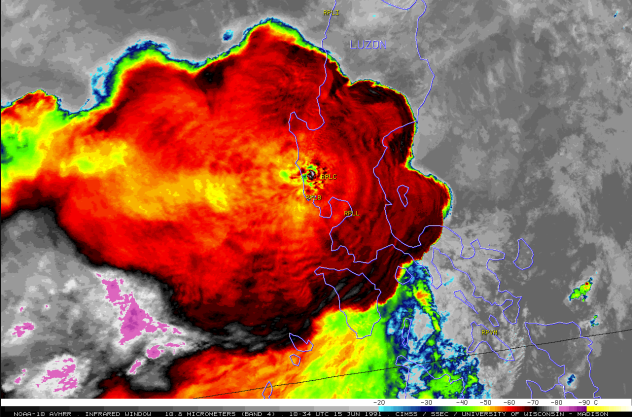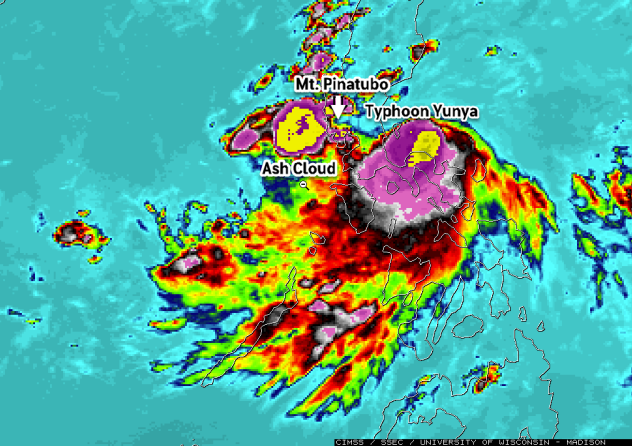Volcano vs typhoon: Island hit by double disasters in one day
On June 15, 1991, the island of Luzon in the Philippines was ground zero for the second-largest volcanic eruption of the 1900s when Mount Pinatubo blew its top. This historic natural event set massive amounts of ash and volcanic debris high into the atmosphere, burying areas surrounding the volcano and even influencing the weather around the globe.
Geologists observed warning signs leading up to the cataclysmic eruption of Mount Pinatubo that helped scientists predict a major eruption was imminent, helping to save the lives of residents living around the volcano.
 |
Mount Pinatubo erupting in June of 1991. (Image/ USGS/ Dave Harlow) |
One of the first signs of life from the volcano occurred on July 16, 1990, when a magnitude 7.8 earthquake jolted Luzon near the site of Pinatubo. This was followed up by smaller earthquakes in the coming months and eventually small eruptions in the days leading up to the climax of the volcano's reawakening.
At 1:42 p.m. PHT (Philippine Standard Time), the catastrophic eruption of Mount Pinatubo began.
A cloud of hot volcanic ash raced upward through the atmosphere, reaching as high as 22 miles above the ground into the stratosphere, the USGS said. This is more than three times higher than commercial airplanes fly when at cruising altitude.
 |
Infrared satellite photo of Mt. Pinatubo ash cloud on June 15, 1991 (CIMSS/NOAA-10 AVHRR) |
As an ominous black cloud grew overhead, pyroclastic flows and lahars wiped out the landscape and the infrastructure nearby. Ash later accumulated on some of the areas devastated by these intense debris flows, with ash falling as far away as the Indian Ocean.
The eruption alone was a significant event, but conditions were even worst than expected as two forces of nature clashed.
On the same day that Mount Pinatubo erupted, Typhoon Yunya made landfall on Luzon in the Philippines.
The eruption was so powerful that despite the wind and strength of Yunya, a black plume of volcanic ash blasted through the clouds swirling around the center of the typhoon. Yunya then weakened to tropical storm strength, but its impact was significant.
 |
Infrared satellite photo of Typhoon Yunya and Mt. Pinatubo eruption on June 14, 1991 (CIMSS/GMS-4 Satellite) |
A post-storm analysis by the Joint Typhoon Warning Center (JTWC) found that the typhoon compounded the issues created by the volcano across the Philippines.
Instead of the ash being carried out to sea, the circulation around the typhoon redistributed the ash over land as it rained down with the downpours associated with the typhoon.
"This greatly aggravated the impact of the water-laden ash fallout," the JTWC said, "resulting in the downing of power lines and the collapse of most flat-roofed buildings due to overloading."
 |
A plume of volcanic ash bursting through the clouds of Typhoon Yunya in June of 1991. (NOAA) |
This eruption claimed the lives of around 800 people, but this number could have been much higher if it were not for officials evacuating 20,000 people from the region.
The eruption had far-reaching effects well outside of the Philippines.
"Volcanoes do affect the weather, and some major ones affect the climate if you define climate as anything beyond a year or two," Dr. Joel Myers, Founder, President and Chairman of AccuWeather, said.
When major eruptions occur, and gas and ash are lofted into the stratosphere, it can reflect sunlight, resulting in lower air temperatures near the surface. This was exactly what happened following the Pinatubo eruption.
 |
Part of the cataclysmic eruption of Mount Pinatubo was shrouded by clouds and rain due to Typhoon Yunya. (Image/ NOAA/NGDC, R. Lapointe, U.S. Air Force) |
"Nearly 20 million tons of sulfur dioxide were injected into the stratosphere in Pinatubo's 1991 eruptions, and dispersal of this gas cloud around the world caused global temperatures to drop temporarily (1991 through 1993) by about 1°F (0.5°C)," the USGS explained.
The location of Pinatubo also played a role in the dip in global temperatures as it sits relatively close to the equator.
"Because of atmospheric circulation patterns, eruptions in the tropics can have an effect on the climate in both hemispheres while eruptions at mid or high latitudes only have impact the hemisphere they are within," researchers at the University Corporation for Atmospheric Research in Boulder, Colorado, said.
CLICK HERE FOR THE FREE ACCUWEATHER APP
If an eruption of a similar magnitude happened closer to the North Pole or the South Pole, it would have more of an impact across the hemisphere that the volcano is located in rather than around the entire planet.
Even though this single eruption was the second-largest in the world during the 20th century, it was the smallest eruption in Pinatubo's geologic history, according to the USGS.
The event may have happened 30 years ago, but the region around the volcano has not returned to the way that it was before the eruption, and residents always have the fear of another eruption in the back of their minds.
"We do not expect another explosive eruption as large as that of June 15, 1991, but we would not be surprised to see some moderate-size explosive events," the USGS said.
Keep checking back on AccuWeather.com and stay tuned to the AccuWeather Network on DirecTV, Frontier, Spectrum, FuboTV, Philo, and Verizon Fios.






